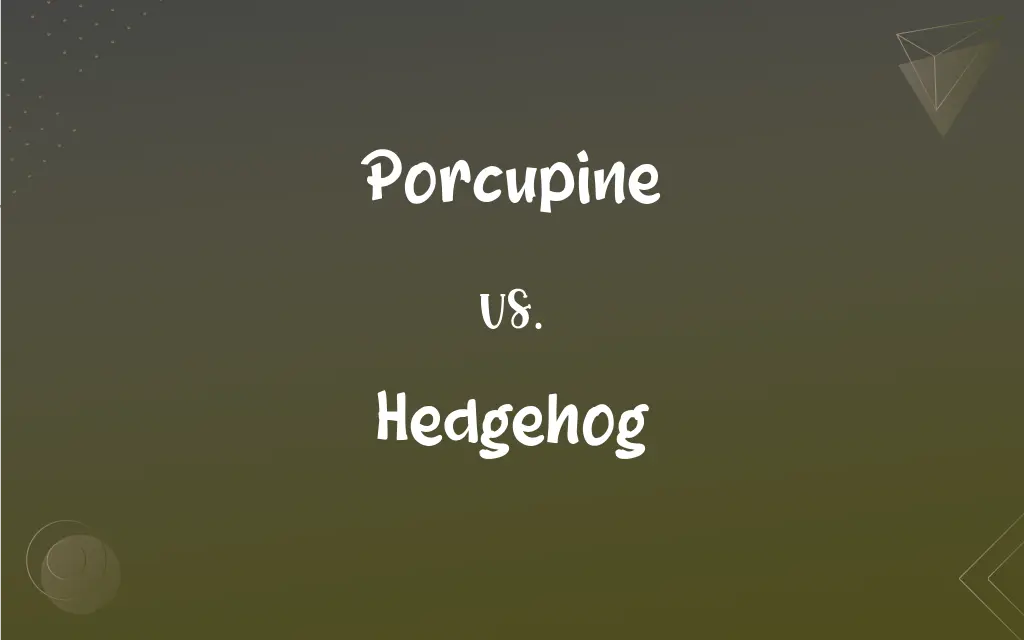Porcupine vs. Hedgehog: What's the Difference?
Edited by Aimie Carlson || By Harlon Moss || Updated on October 23, 2023
Porcupines are larger rodents with long quills, while hedgehogs are smaller mammals with short spines.

Key Differences
Porcupines and hedgehogs are both known for their sharp, spiky exteriors, but they hail from distinct families in the animal kingdom. Porcupines belong to the rodent family and are native to the Americas and parts of Asia. They have long, barbed quills that can detach when threatened, acting as a defense mechanism. Hedgehogs, on the other hand, are part of the Erinaceidae family, predominantly found in Europe, Asia, and Africa. Their spines are shorter and more rigid, providing protection but not detaching as easily as porcupine quills.
Another notable distinction between porcupines and hedgehogs concerns their size and physical appearance. Porcupines are generally larger, sometimes weighing over 20 pounds, and can have quills that stretch several inches long. Hedgehogs, conversely, are more compact creatures, often weighing between 1 to 2 pounds with spines that are only about an inch long. While porcupines have a tail, hedgehogs do not possess a prominent tail, and their appearance is more rounded.
Habitats and behaviors of porcupines and hedgehogs further differentiate them. Porcupines can be either tree-dwelling or ground-dwelling, depending on the species, and are often solitary in nature. They feed primarily on plants, wood, and bark. Hedgehogs, in contrast, are strictly ground-dwelling creatures that often seek shelter in burrows or underbrush. They are insectivores, predominantly consuming insects, but can also eat plants and small vertebrates.
In popular culture, both porcupines and hedgehogs hold a unique place. The quills of a porcupine are frequently associated with a defensive or aggressive stance, representing the idea of self-protection. Hedgehogs, with their more compact and cute appearance, often symbolize cuteness or innocence. However, despite these symbolic associations, it's crucial to understand and appreciate the biological and ecological roles both these creatures play in their respective habitats.
Comparison Chart
Family
Rodents (Rodentia)
Erinaceidae
ADVERTISEMENT
Habitat
Americas, parts of Asia
Europe, Asia, Africa
Size
Larger (up to 20+ pounds)
Smaller (1-2 pounds)
Defense Mechanism
Long, detachable quills
Short, non-detachable spines
Diet
Plants, wood, bark
Insects, plants, small vertebrates
Porcupine and Hedgehog Definitions
Porcupine
A member of the rodent family with long, detachable spines.
The dog learned quickly to avoid the porcupine after a painful encounter.
ADVERTISEMENT
Hedgehog
A creature from the Erinaceidae family with short, rigid spines.
The hedgehog's spines stood up when it sensed danger.
Porcupine
An animal with barbed quills as a defense mechanism.
When threatened, the porcupine raised its quills in defense.
Hedgehog
A small mammal with protective spines.
The hedgehog curled into a ball when I approached.
Porcupine
A herbivorous creature that feeds on plants, wood, and bark.
In the forest, the porcupine gnawed on a piece of bark.
Hedgehog
An insectivore native to Europe, Asia, and Africa.
I watched the hedgehog hunt for insects in the garden.
Porcupine
A rodent known for its sharp quills.
I once saw a porcupine in the woods, its quills standing on end.
Hedgehog
A nocturnal mammal known for its rounded appearance and lack of tail.
At night, the hedgehog ventured out in search of food.
Porcupine
A spiky mammal native to the Americas and parts of Asia.
The porcupine climbed the tree effortlessly, seeking food.
Hedgehog
A ground-dwelling animal often found in burrows or underbrush.
The hedgehog made its home beneath the hedgerow.
Porcupine
Any of various rodents of the family Hystricidae, of Eurasia and Africa, or the family Erethizontidae, of the Americas, having long, sharp, erectile quills.
Hedgehog
Any of several small insectivorous mammals of the subfamily Erinaceinae, native to Eurasia and Africa and naturalized in New Zealand, having dense erectile spines covering the back and sides and characteristically rolling into a ball for protection.
Porcupine
Any of several rodents of either of the taxonomic families Hystricidae (Old World porcupines) or Erethizontidae (New World porcupines), both from the infraorder Hystricognathi, noted for their sharp spines or quills, which are raised when the animal is attacked or surprised.
Porcupine
Any Old Word rodent of the genus Hystrix, having the back covered with long, sharp, erectile spines or quills, sometimes a foot long. The common species of Europe and Asia (Hystrix cristata) is the best known.
Porcupine
Any species of Erethizon and related genera, native of America. They are related to the true porcupines, but have shorter spines, and are arboreal in their habits. The Canada porcupine (Erethizon dorsatus) is a well known species.
Porcupine
Relatively large rodents with sharp erectile bristles mingled with the fur
FAQs
Where are porcupines commonly found?
Porcupines are native to the Americas and parts of Asia.
Do porcupines shoot their quills?
No, porcupines do not shoot their quills, but they can detach and embed in predators when touched.
Are porcupines related to hedgehogs?
No, porcupines are rodents, while hedgehogs belong to the Erinaceidae family.
Do hedgehogs hibernate?
Yes, some species of hedgehogs hibernate during colder months.
What is a hedgehog?
A hedgehog is a small mammal covered in short, rigid spines for protection.
Do hedgehogs swim?
Yes, hedgehogs can swim, but they may not necessarily enjoy it.
What is a porcupine?
A porcupine is a rodent known for its long, sharp quills used for defense.
How big can a porcupine get?
Porcupines can weigh over 20 pounds, depending on the species.
What's the main difference between a porcupine and hedgehog?
Porcupines are larger rodents with long quills, while hedgehogs are smaller mammals with short spines.
Is it safe to touch a hedgehog?
While hedgehogs' spines are less dangerous than porcupine quills, it's best to handle them with care.
What do hedgehogs eat?
Hedgehogs primarily eat insects but can also consume plants and small vertebrates.
How do hedgehogs protect themselves?
Hedgehogs curl into a ball, exposing their spines outward as a defense mechanism.
Are porcupine quills poisonous?
No, porcupine quills are not poisonous but can cause painful injuries.
Do both porcupines and hedgehogs have predators?
Yes, both have natural predators; however, their spiky defenses help deter many potential threats.
Do hedgehogs make good pets?
With proper care, some species of hedgehogs can be kept as pets, but they have specific needs.
How fast can a hedgehog run?
Hedgehogs can run up to 3-4 miles per hour.
Can porcupines be domesticated?
Porcupines are wild animals and are not typically kept as pets.
What sounds do porcupines make?
Porcupines can produce a range of sounds, including grunts, whines, and shrieks.
How long do hedgehogs live?
In the wild, hedgehogs live 3-5 years, but in captivity, they can live up to 10 years.
Do porcupines climb trees?
Yes, some species of porcupines are adept climbers and dwell in trees.
About Author
Written by
Harlon MossHarlon is a seasoned quality moderator and accomplished content writer for Difference Wiki. An alumnus of the prestigious University of California, he earned his degree in Computer Science. Leveraging his academic background, Harlon brings a meticulous and informed perspective to his work, ensuring content accuracy and excellence.
Edited by
Aimie CarlsonAimie Carlson, holding a master's degree in English literature, is a fervent English language enthusiast. She lends her writing talents to Difference Wiki, a prominent website that specializes in comparisons, offering readers insightful analyses that both captivate and inform.






























































